Art interrupted: part 2
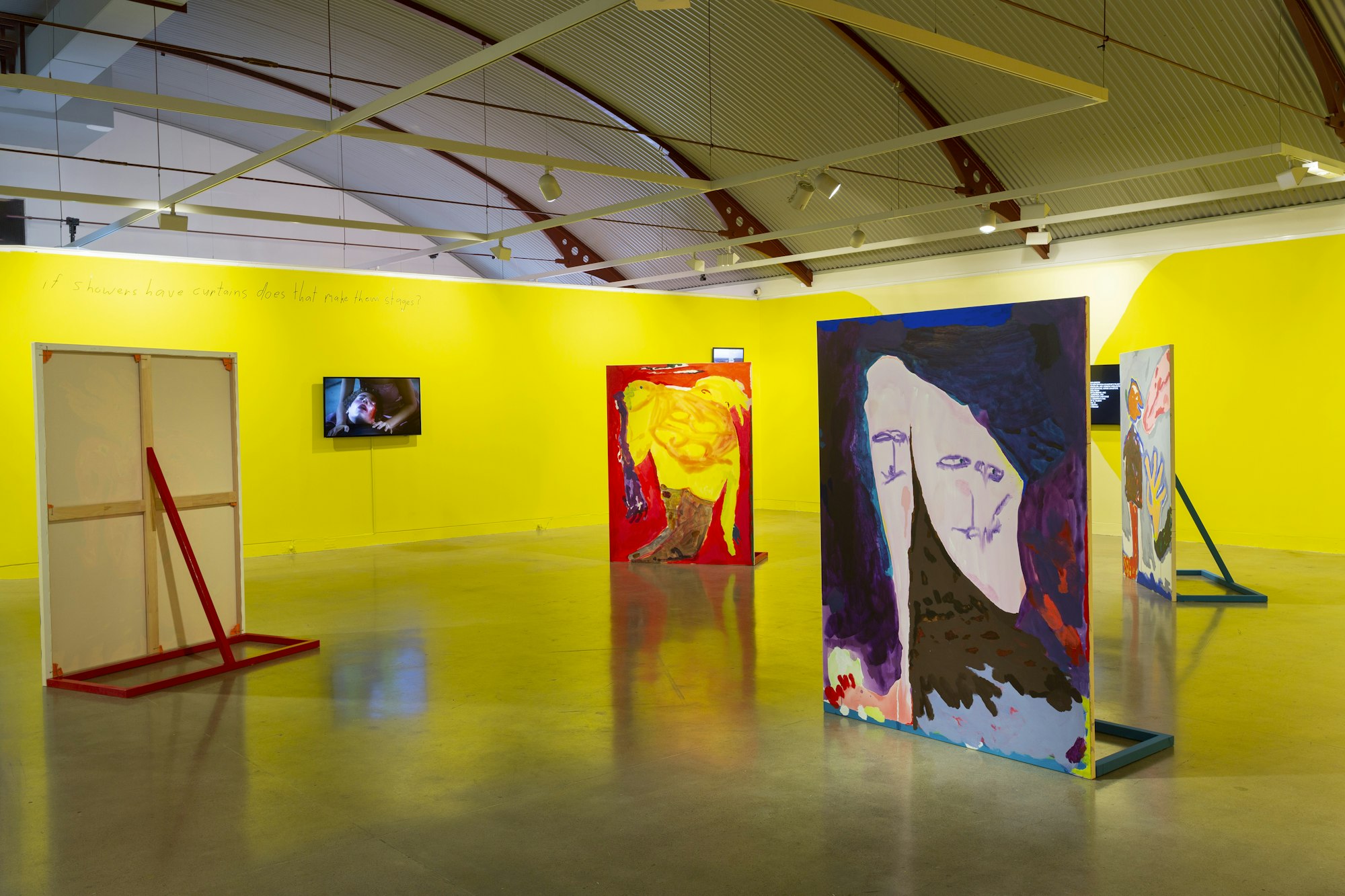
Works by Tom Polo and Campbell Patterson in Contact Us, installation view, Cement Fondu, 2020. Photo: Jessica Maurer
This is not the way this article was going to begin.
It was intended as a homage to more ‘ghost exhibitions’ – shows interrupted or never launched because of COVID-19 closures. But with news this week of the dynamic Sydney institution Carriageworks entering voluntary administration, we need also to acknowledge a potential larger loss from our shared cultural landscape.
Beyond temporary interruptions to individual exhibitions, the pandemic presents a serious threat to the viability of arts organisations and the livelihoods of many friends and colleagues. Two Carriageworks exhibitions are singled out for praise in the responses below. We salute the artists and arts workers who made those and many other amazing shows happen in that historic space. We hope to visit and see art thriving there again.
Read on to hear from staff across the Art Gallery of NSW about the exhibitions they wished they’d seen in person before the pandemic interrupted.
Isobel Parker Philip, senior curator, contemporary Australian art
The art world is not simply an industry, it is a community – a community that, like most, finds itself in a state of shock. The primary point of contact on which our world turns – the interaction between an artwork and its audience – has been neutered. It’s not just disappointing that we can’t see these exhibitions; it’s devastating. To show up is to support. There are so many exhibitions I’m devastated to miss. Among them is Contact Us at Cement Fondu in Sydney, featuring Emma Finneran, Campbell Patterson and Tom Polo. This is an exhibition about social interaction, about gesture and its residue. The grease a body leaves behind, as a kind of incidental mark-making, in Emma’s frosted glass mural; the stolen glances that dart between the figures in Tom’s self-standing paintings (paintings that must be seen in situ, for they have physiques); the intimacy of an abject object in Campbell’s arrangement of toiletries abandoned by strangers in a local gym. The spectre of social distancing can’t but amplify the poignancy of this show. It’s in the gallery’s bathroom that the (portentous) penny drops, but I’ll leave that gem (or germ?) for the virtual tour.
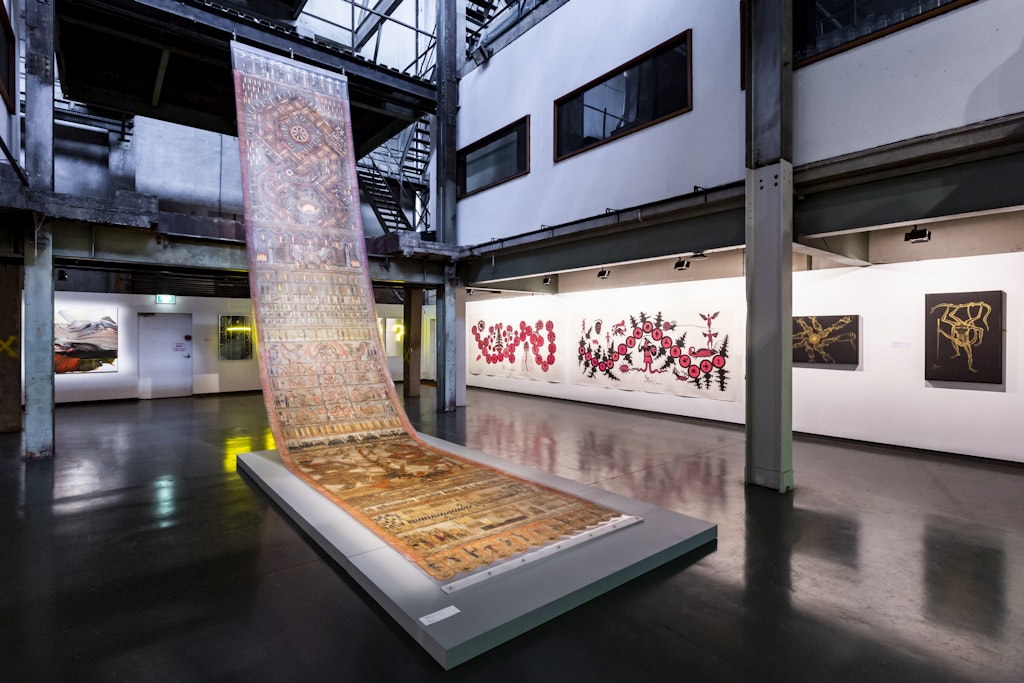
Pulse of the Dragon, installation view, Casula Powerhouse Arts Centre, 2020. Photo: Chantel Bann
Yin Cao, curator of Chinese art
Art can encourage compassion, fellow feeling and cross-cultural understanding. Such understanding is especially important in the moment of COVID-19, when many Australians of Chinese heritage have experienced unkindness and abuse. For this reason I felt sad to see that the Casula Powerhouse Arts Centre’s exhibition Pulse of the Dragon, which opened on 22 February, had to close after a month. The show featured ten contemporary Chinese and Chinese-Australian artists, including Guan Wei (also currently on the walls of the closed Art Gallery of NSW in the exhibition In One Drop of Water), Cang Xin, Jin Sha and Yang Xifa, who responded to five elements of Chinese tradition: religious witchcraft, mythology, folk art, folk culture and the literati spirit. The Chinese artists invited to come to Sydney for the opening were unable to visit due to the pandemic, but it is important to welcome them in spirit by acknowledging their creations.
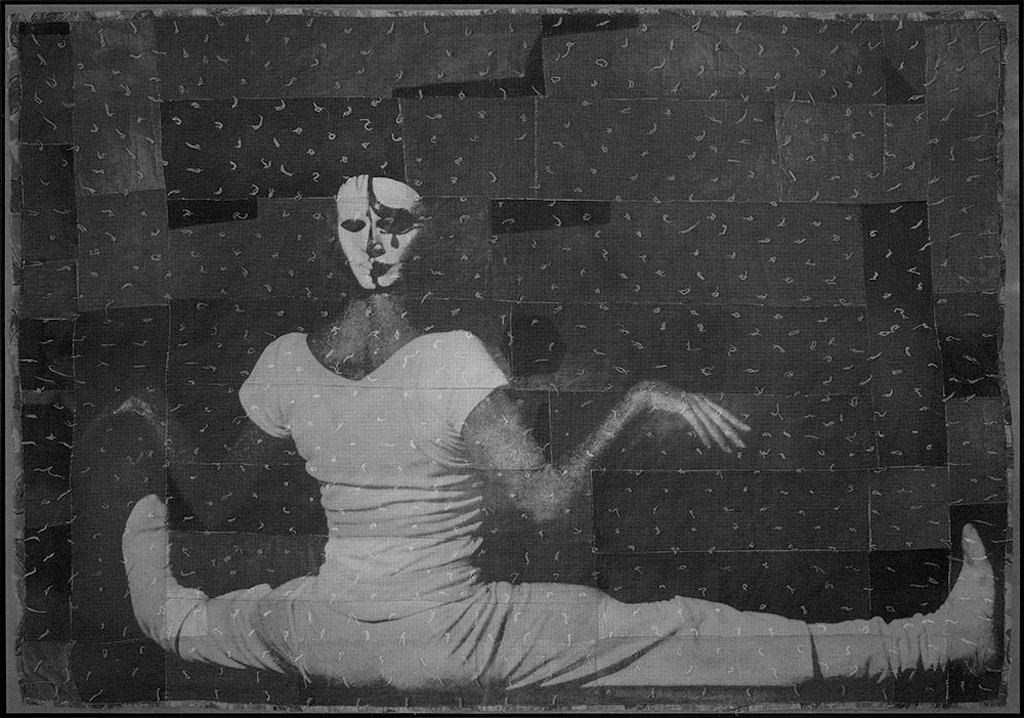
David Noonan Mask 2015, Art Gallery of Ballarat © David Noonan
Jackie Dunn, special exhibitions curator
I’ve long been a fan of David Noonan’s moody enigmatic works – the source of whose emotive power I can never quite put my finger on (just how I like a work of art to behave). I might not have managed to make it to Ballarat to see Noonan’s ‘mini survey’ Stagecraft, but I had good intentions nonetheless. Curator and Ballarat local Julie McLaren has done what I so admire in our exceptional regional galleries: find the local connection (Noonan was born and studied there), build the relationship ‘from within’ (out of two key collection works) and thoughtfully curate a singular exhibition (in this case, resonating with the approach of the artist). Well, they seem to have done so, from what I can see via the excellent online material, which includes a video. But of course, Noonan’s collages are never just ‘images’; they are attentively layered textiles and as such (as in all material artworks) need to be experienced in the flesh.
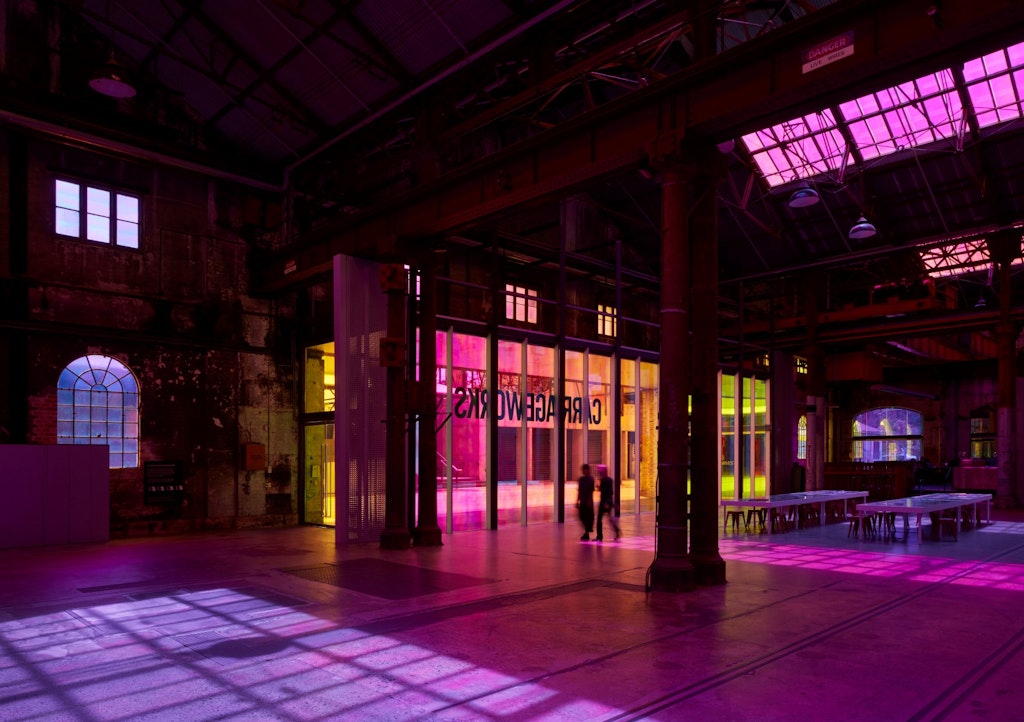
Rebecca Baumann Radiant flux 2020, installation view, Carriageworks. Photo: Zan Wimberley
Katy Preston, exhibition manager
When Rebecca Baumann’s site-specific installation Radiant flux opened at Carriageworks in January, I marked it down as a ‘must see’. I was grateful the show ran until June, allowing plenty of time to immerse myself in Baumann’s ever-shifting kaleidoscopic transformation of a space I have always cherished. But, caught up in the pace of life (a never-ending cycle of exhibitions), I still hadn’t found a moment to experience the sense of wonder and calm evoked by Rebecca’s artwork by the time Carriageworks was forced to close its doors. Now, I sit within my apartment and watch the light shift across the same space each day as the world outside changes in ways we never thought possible. I find myself contemplating the impermanence Baumann highlights with such exquisite subtlety, and how, more than ever, we should make time to slow down and see all that is luminous in the world.
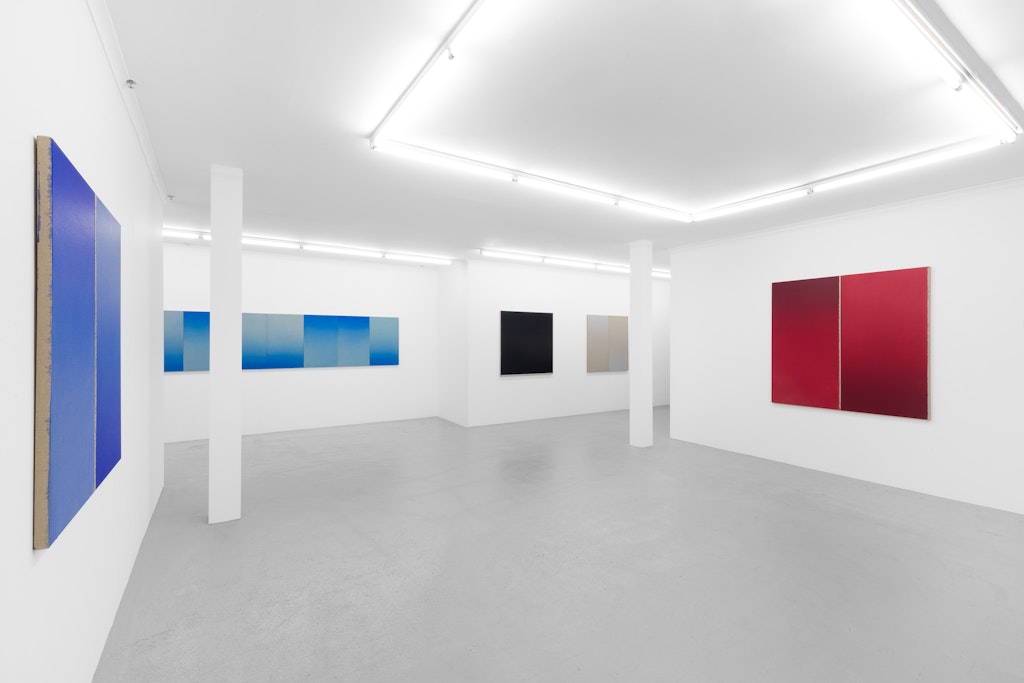
Nancy Constandelia Slow Motion, installation view, Galerie pompom, Sydney, 2020. Photo: Docqment
Saha Jones, next generation development manager
The Biennale of Sydney had only just begun when social distancing restrictions started to take effect in March. To witness a phenomenally powerful Black-Lives-Matter kind of energy in the Gallery during the install made 2020 seem ripe with promise. But suddenly, from big theatre and dance productions through to small backyard poetry slams our art events were GONE. Choosing a ghost in a graveyard is hard. I was really looking forward to a vegetarian art-dinner hosted for the Gallery’s Atelier benefaction group by Galerie pompom and Art Month. Intended to be the first in a series of seasonal edible adventures, it was going to be a collaboration between renowned forager and environmental artist Diego Bonetto and designer, foodie and weed convert Marnee Fox. Artist Nancy Constandelia was also going to give a talk on her exhibition Slow Motion – its title echoing our present need to slow down, take stock, reset, reimagine and digest. We must remember that arts and culture are like food. We are nourished by them and they, in turn, are sustained by our love and support.
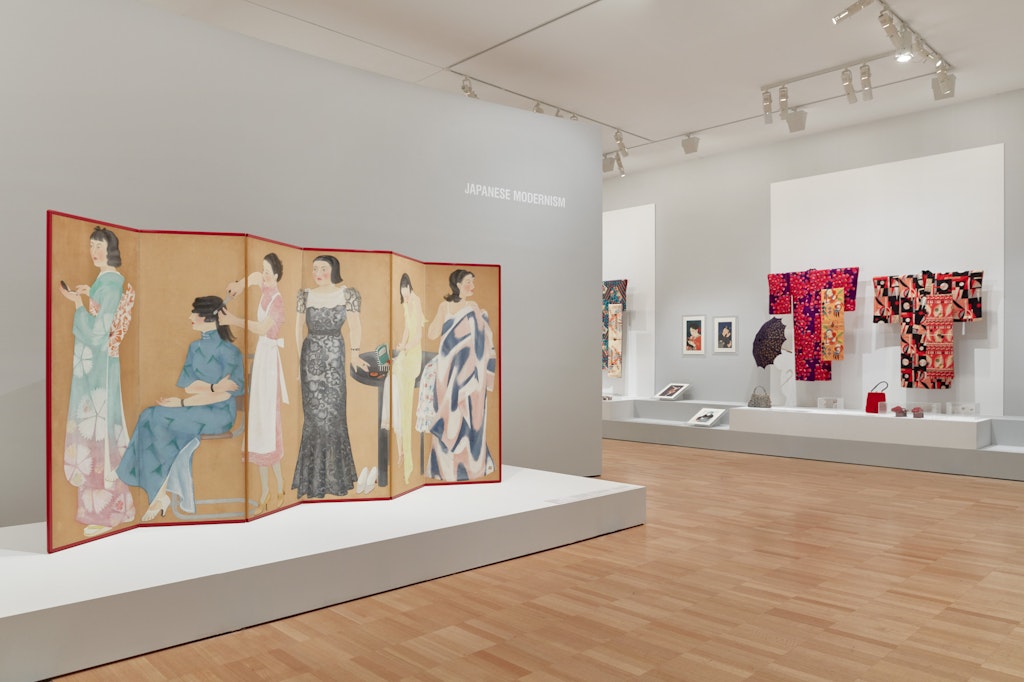
Japanese Modernism, installation view, National Gallery of Victoria, Melbourne, 2020. Photo: Tom Ross
Melanie Eastburn, senior curator, Asian art
I had been looking forward to revelling in exuberant fashion, advertising posters, jazz album covers, powder compacts and sparkling cut glass in Japanese Modernism at the National Gallery of Victoria. The exhibition celebrates the explosion of modern life and deco glamour in Japan, especially in Tokyo as it rebuilt following the Great Kanto Earthquake in 1923. The city was alive with new subways, department stores, cafes and dancehalls frequented by liberated bob-haired moga (modern girls) and their mobo (modern boys). I first fell in love with this world (and the mobo who introduced me to it) in 1998 when I saw the exhibition Modern Boy, Modern Girl at the Art Gallery of NSW. With so much of Japanese Modernism online – images, label texts, essays and a tour – for now I will enjoy it from home.
![Hugh Ramsay [w:849[The sisters]] 1904, Art Gallery of New South Wales](https://www.datocms-assets.com/42890/1632888397-849-mm.jpg?fit=clip&iptc=allow&w=1024)
Hugh Ramsay The sisters 1904, Art Gallery of New South Wales
Ron Ramsey, executive director, Art Gallery Society of New South Wales
Foiled by the season of smoke and bushfires and then the destructive hailstorm, I waited for the perfect time to view the Hugh Ramsay exhibition at the National Gallery of Australia. The World Federation of Friends of Museums had been planning their world congress for two years and it was to be held in a sublime, autumnal Canberra from 26 to 30 March 2020. The Ramsay show was one of many highlights for the national and international delegates. Much like Ramsay’s tragically short life (he died of tuberculosis at age 28), this exhibition and other rich cultural opportunities were cruelly taken from us by another serious illness. I now like to think of Nell and Madge, the young women portrayed in Ramsey’s masterpiece The sisters 1904 as they sit socially isolated, like many of us, but dressed in their best gowns, anticipating the day they can return to the walls of the Art Gallery of NSW.
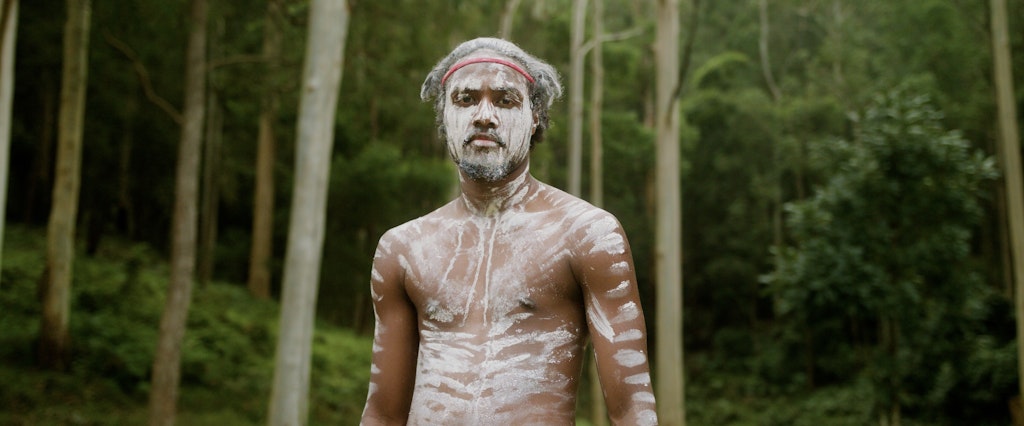
Ryan Lee Wonnarua 2020 from Emerging 2020, Gosford Regional Gallery
Ana Becerra, philanthropy coordinator
In 2019, not long after I moved from Sydney to Gosford, I found myself at the Gosford Regional Gallery. I joined as a member with the intention of becoming a frequent visitor, but commuting and other commitments have often got in the way. Last month, I looked forward to attending the openings of Emerging 2020 and Robyn Pedley’s exhibition Coastal Sanctuaries. To me, these two very different exhibitions demonstrate the importance of regional galleries. They provide a platform for young local artists to exhibit their works at a public gallery and offer a generosity of space for more established artists to explore a sense of place. Meanwhile, my enforced time at home has prompted me to reflect on missed opportunities to connect with my new community through art. I know that when we re-emerge, I will make it a priority to revisit my local gallery and celebrate and support the creativity that surrounds me.
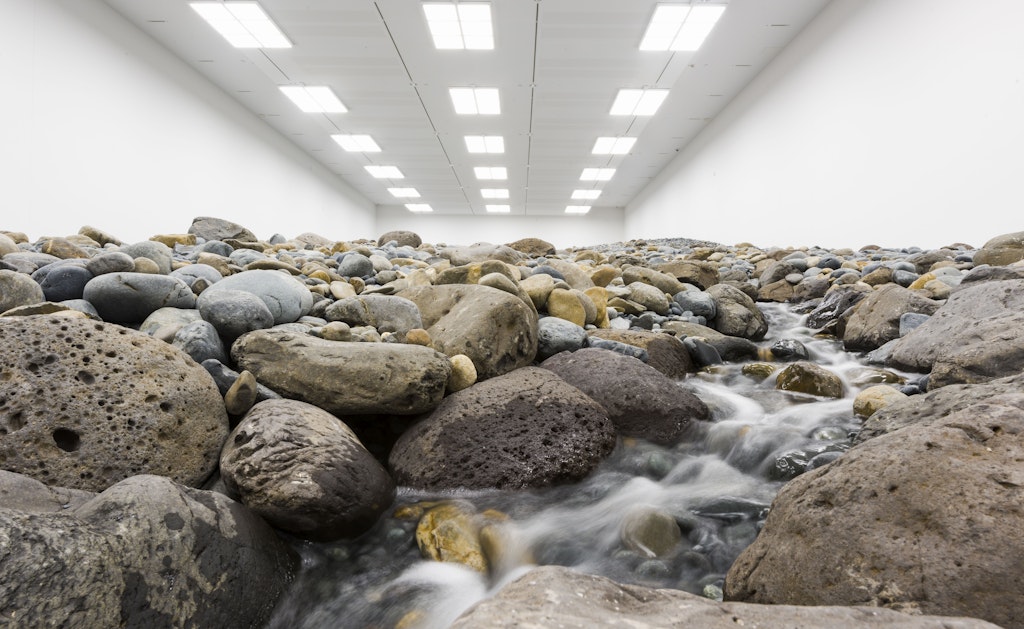
Olafur Eliasson Riverbed 2014, installation view, Gallery of Modern Art, Brisbane, Australia. Courtesy the artist; neugerriemschneider, Berlin; Tanya Bonakdar Gallery, New York / Los Angeles. Photo: Natasha Harth, QAGOMA
Kirsten Tilgals, online producer
Before COVID-19 made everyone rethink non-essential travel, I had planned a road trip in March, with the aim of spending needed tourist dollars in some bushfire-affected regions and swimming at various spots along the coast. The furthest point north was to be Brisbane, where we would immerse ourselves in Water at QAGOMA. The exhibition’s theme now has an unexpected resonance for me, because I live in a tiny apartment by the sea. We’d always commented that space wasn’t an issue because the beach was like our backyard – but not at the moment. There are guards and barricades and, even if you’re lucky enough to get a toe in the water, there’s no chance to frolic or lounge in the sand. Sadly, I won’t be able to see Water (it closed on 23 March, although there’s an assortment of content online) but I can still see, hear and smell the sea, and – like art – it still stirs and soothes.
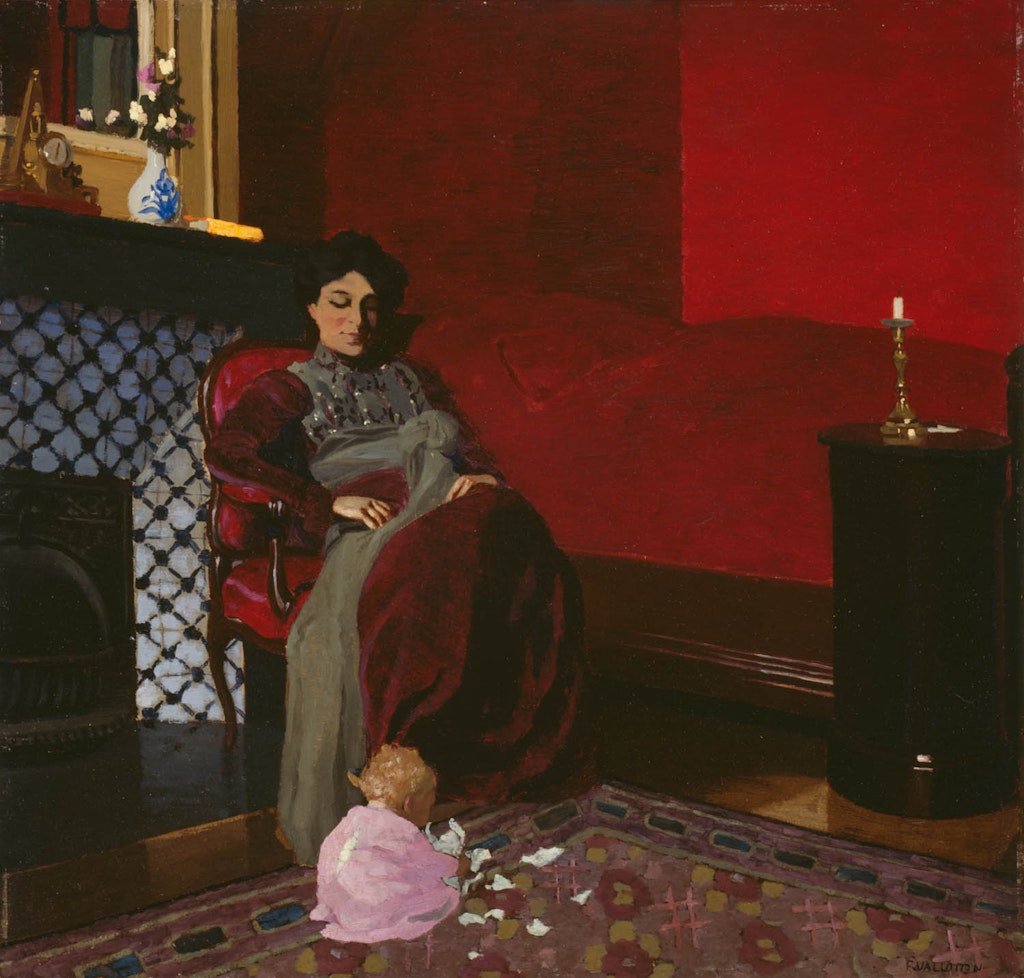
Félix Edouard Vallotton The Red Room, Etretat 1899. Courtesy the Art Institute of Chicago
Julie Donaldson, publishing manager
In July I was to attend the biennial National Museum Publishing Seminar in Chicago. My research for not-to-miss exhibitions during my trip included this beauty: Intimate Modernity at the Art Institute of Chicago. The works in this show echo our current lives in our smaller and intimate iso-worlds. It includes shimmering and strangely beautiful paintings from the late 1800s by artists such as Pierre Bonnard, Suzanne Valadon, Félix Vallotton and Edouard Vuillard, my all-time favourite artist of this period. These artists were known as Intimists, creating small-scale views of everyday interior worlds that pulse with colour and pattern – so much pattern! The occupants of Vuillard’s interiors seem to squeeze or slide between the layers of wallpaper and upholstery – at once enclosed and energised by their domestic surroundings.
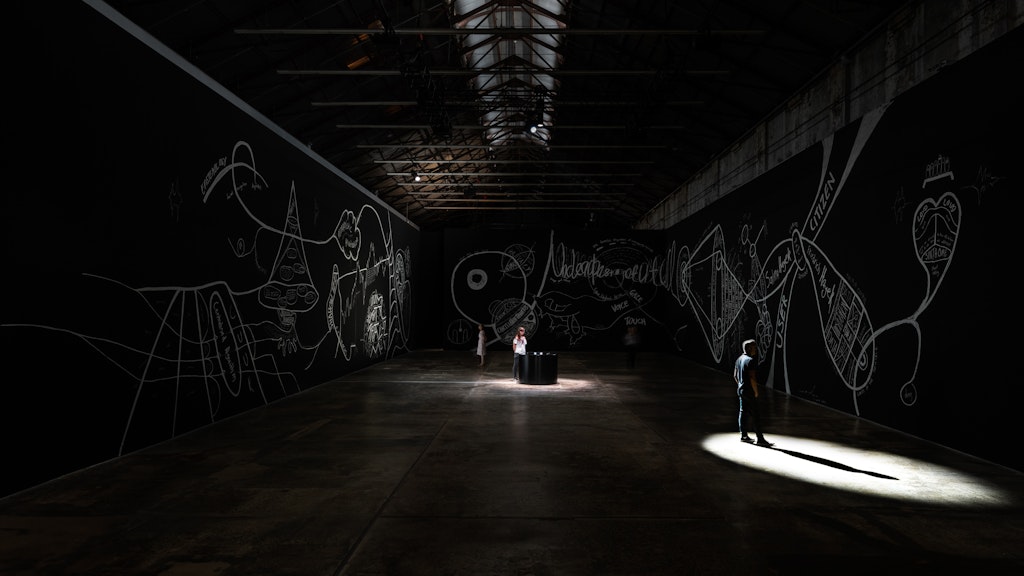
Giselle Stanborough Cinopticon (Wall), installation view, Carriageworks, Sydney, 2020. Photo: Mark Porkorny
Matt Cox, curator, Asian art
In February, I contacted Giselle Stanborough via her personalised dating app after hearing about her work from fellow Gallery curator Nick Yelverton. For someone like me, who has until now successfully navigated life without social media, the experience of meeting an artist (for professional reasons) through a dating app was novel. We charted possible dates to meet and settled on visiting her show, Cinopticon, which was scheduled to open at Carriageworks on 27 March. Needless to say, I didn’t get a chance to meet Giselle or see the show. Giselle’s work, which oscillates between our lived experience of the world and the virtual sites we inhabit, seems very well suited to our current predicament. Thankfully for us, her show has morphed into an online platform that addresses internet narcissism and our paradoxical desire to reveal our virtual selves to others, even while we seek protection in our homes.
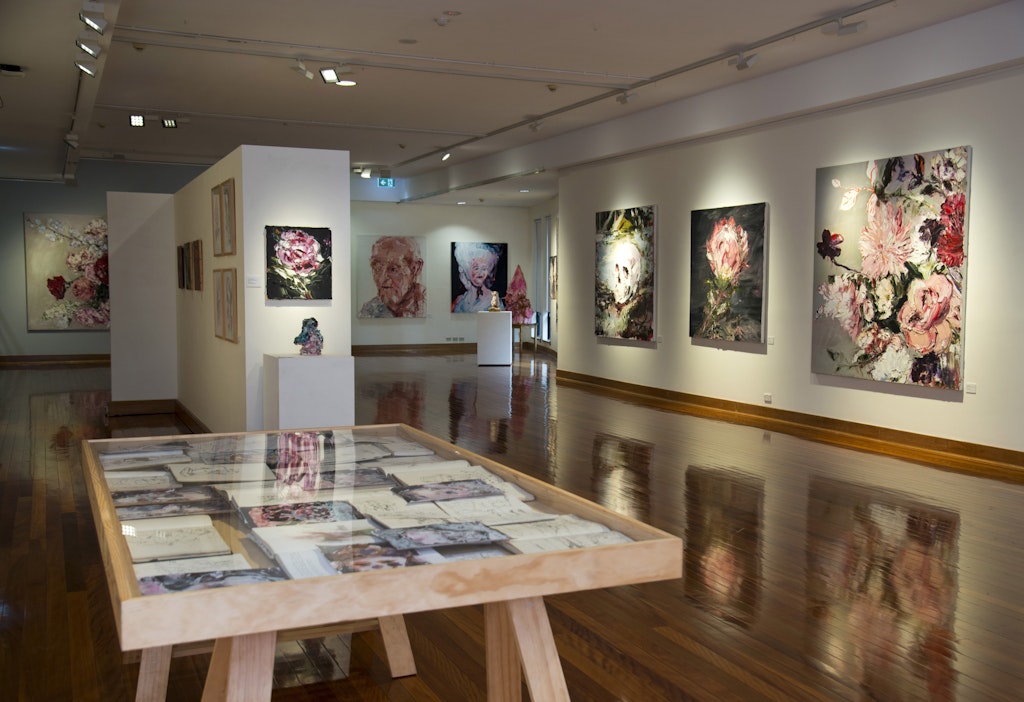
Where the Wild Things Grow: Craig Waddell Survey, installation view, Macquarie University Art Gallery, 2020. Photo: Effy Alexakis
Eric Riddler, visual resources librarian
Award-winning Sydney artist Craig Waddell talks about painting life cycles and ‘the studio as a sanctuary’. So I was looking forward to my own moments of calm with his exhibition Where the Wild Things Grow at Macquarie University Art Gallery. The exhibition spanned two decades, exploring the processes, overlaps and interconnections within his richly painted body of work. Engaged with art history and the residues of the past, Waddell uses still life and landscape to address, in his words, ‘love, loss and longing’. I was particularly looking forward to Waddell’s landscape paintings, which contrasted the outer Sydney orchard of Waddell’s youth with Tasmanian wilderness and Central Australian deserts. For now, I’ll just have to go there in imagination – or virtually, via the online tour.
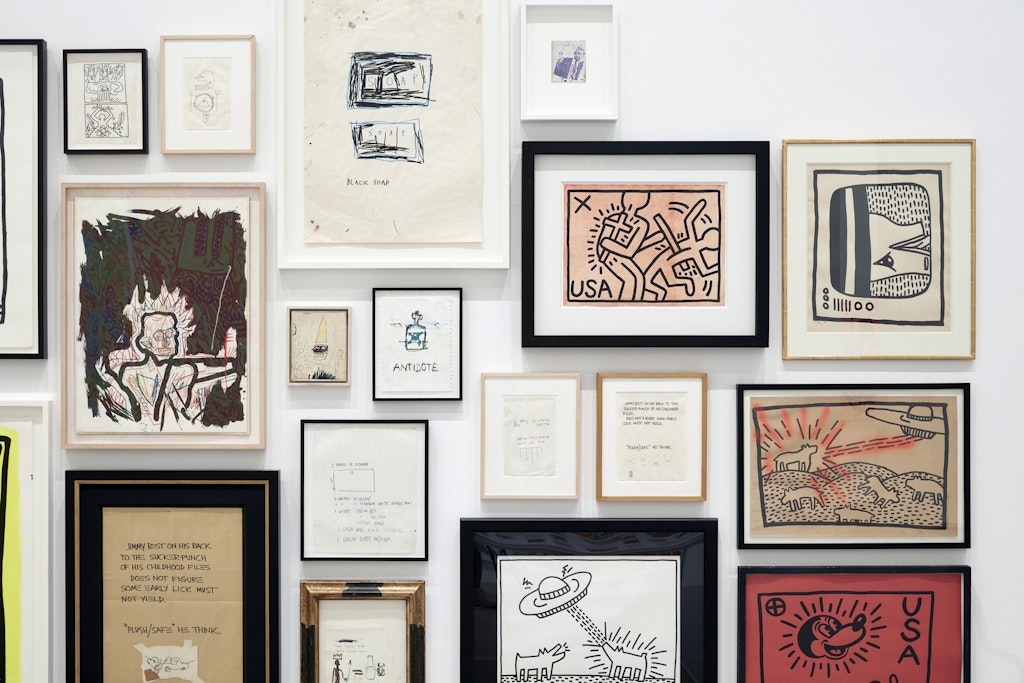
Keith Haring | Jean-Michel Basquiat: Crossing Lines, installation view, NGV International, 2019-20 © Estate of Jean-Michel Basquiat. Licensed by Artestar, New York © Keith Haring Foundation. Photo: Sean Fennessy
Alexandra Hardy, public programs producer
COVID-19 stole my chance to catch the Keith Haring | Jean-Michel Basquiat: Crossing Lines show at the National Gallery of Victoria. It was to be a treat to myself for getting through January and February, which are some of the most dynamic programming months for Art After Hours. Having just wrapped up Queer Art After Hours and watched the Biennale of Sydney being installed, it felt like perfect timing to dive into the worlds of two pivotal and political artists. I always love the NGV’s exhibition design and was particularly interested to see how their Friday Nights worked with DJs instead of band sets; alas, it wasn’t meant to be. But, thanks to a YouTube video, I can travel back in time to 1984 to see Keith Haring painting a mural in the Art Gallery of NSW’s own entrance court.